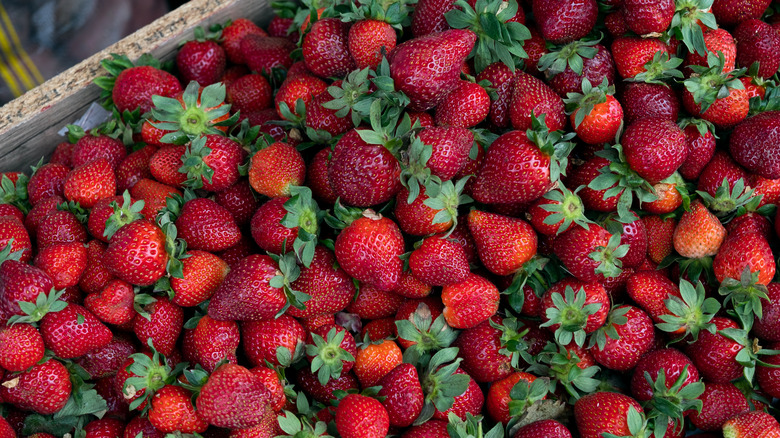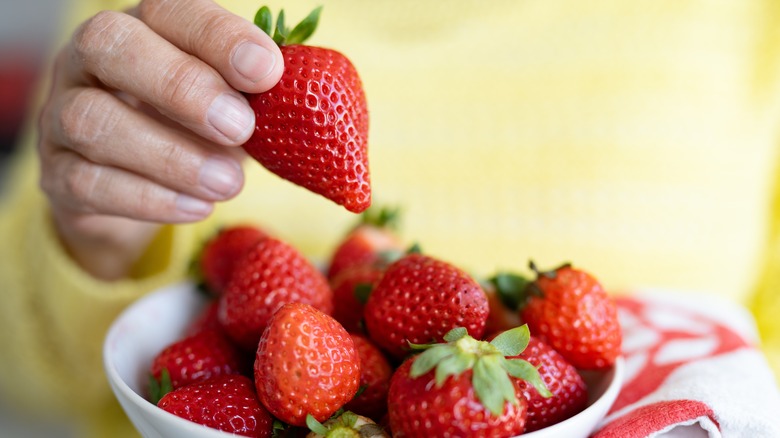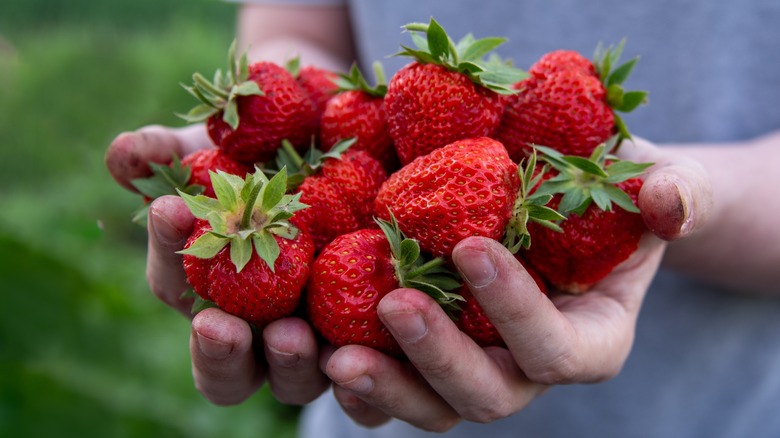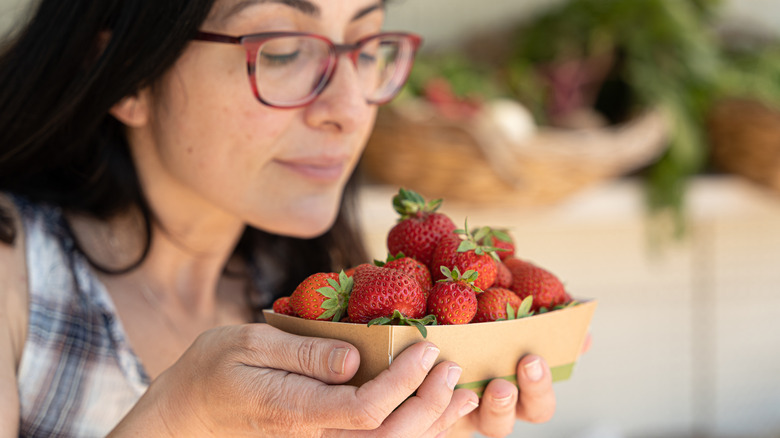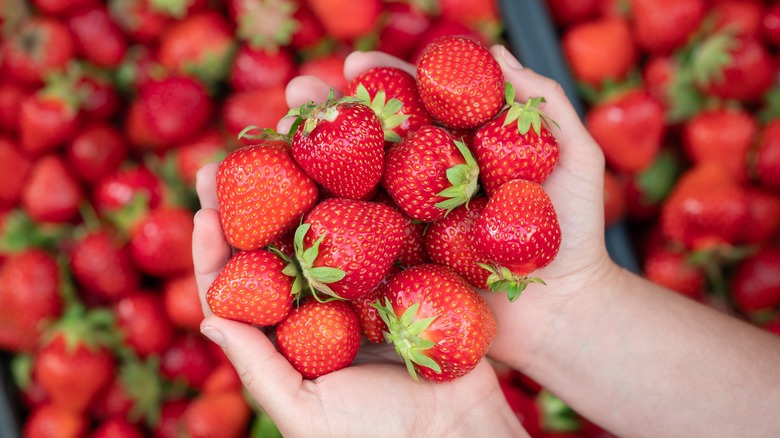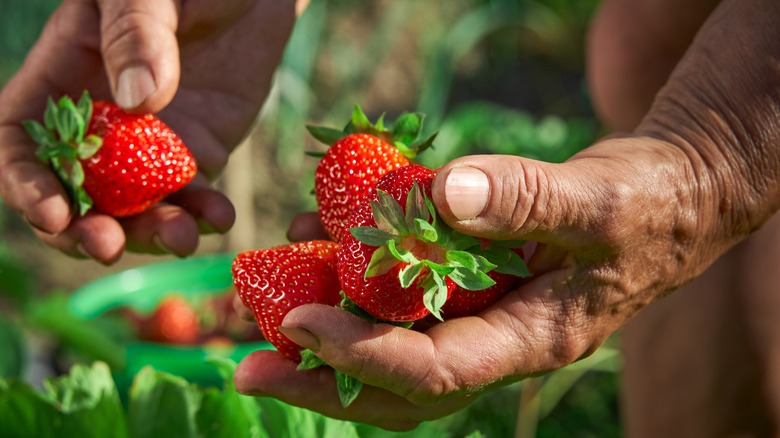The Best Way To Choose Ripe Strawberries At The Store
A strawberry — whole or sliced — is an awesome way to add a burst of life and vibrancy to whichever dish you're making, from crepes to fruit salads. And it's difficult to say no to the sweet, juicy taste you'll enjoy when you bite into them, too.
But strawberries aren't without problems: They're incredibly delicate berries (yes, it's true that strawberries technically aren't berries, but for the sake of easy reading, let's call them so.) If you aren't careful while handling a strawberry, the skin will bruise and the soft, succulent flesh will be damaged. They're also quick to spoil. After just two days in the fridge, their nutritional value starts to decline, and within a week, their overall quality will take a nosedive. This is why you must be really careful when you choose your strawberries while you're out shopping, as bad ones will either taste or look awful. That can seriously mess up whatever plans you've made for these fruits.
Choosing the best strawberries is a skill that takes practice and quite a lot of trial and error. But there are signs that you can look out for that'll help you spot the juiciest, most flavorful berries. There's no promise that these signs and tips will help you become an expert strawberry picker overnight, but as long as you keep them in mind, you're guaranteed to have far fewer bad ones in each bunch you buy from now on.
Color should be red and vibrant
When it comes to picking the best strawberries, color is your first clue. The ideal strawberry should have a bright, vibrant red color all over. They can be a little bit green or white on top, near the leafy crown, but the body must be an even, red coat throughout. If the body of the fruit has mottled white or green spots, then that's a sign that the strawberry hasn't fully ripened yet. You should pay especially close attention to the pointed tip of the strawberry. If it's red, you're likely onto a good one. But if the tip is any other color, it's best to leave that one behind.
Color can also help you spot strawberries that are past their prime. Steer clear of strawberries with white, fuzzy spots (that's mold) or dotted with black, sunken spots on the surface, which are a sign of a disease-stricken strawberry.
You might also notice some strawberries with minor bruising, which appear as darker red, dented areas. If the bruise exceeds half an inch then it's considered a defective strawberry per the USDA. It's better that you don't choose it. If the bruising is smaller, then you can still use it for some recipes where appearance isn't paramount, like for making a frozen strawberry daiquiri. But if you intend to eat them fresh or throw them into a strawberry pasta, leave them behind and pick fresher, undamaged ones, instead.
A fresh-looking green cap at the top
Take a look at the small cluster of leaves that crown the strawberry. Most people simply call them the "strawberry cap," but botanically, they're known as the calyx. This part is more than just a green crown that you'd tug off before eating, as it can actually tell you a lot about the fruit's quality.
When selecting strawberries, look for those with large, full leaves that "bloom" out from the center of the berry. A healthy strawberry should have leaves that are vibrant green and fresh-looking. If the leaves have any discoloration on them, like yellow or black spots, be on your guard. Yellowed leaves often indicate that the strawberry is starting to wilt, while dark, mottled spots could be a sign of disease.
If you want to make extra sure, gently feel the leaves with your fingers. They should be soft and pliable. If the leaves feel dry or brittle and you feel like you're running your hand through dried tea leaves, then it's best to choose a different strawberry — that one most likely won't be any good.
A sweet, fruity scent
Your nose can be a pretty handy guide, too. Ripe strawberries have a very distinct aroma that has been described by lots of people as "caramel-like." This sweet scent is actually due to a compound called HDMF (also known as strawberry furanone) that the strawberry releases when it's at peak ripeness.
To test — if you're shopping someplace where this move would be appropriate — gather a handful of the strawberries and take a whiff. If your nose picks up a sweet, "strawberry-ish" scent, then the odds are great that you're holding some great berries. However, if there's no scent at all, the strawberries might not be fully ripe yet. And, obviously, if you get a pungent, rotten smell, sift through the bunch to see which of the strawberries you're holding is the bad one.
Don't worry too much if you find one bad strawberry in the crate you're sifting through, though. Unlike apples, a single moldy or rough-looking strawberry won't spoil the entire batch. Unless nearly a quarter of the batch is giving you that awful smell, you can throw away the bad ones and take the rest if they meet all the other quality criteria.
Texture has to be firm, but not mushy
Now that you've sorted through the appearance and the scent of the strawberries, it's time to test the texture. You've probably seen a lot of seasoned pickers giving berries gentle squeezes and magically knowing if they're good ones or not. That's what you'll be doing, too — if you're shopping someplace where it would be okay to handle the berries before buying. (If not, save this tip for the next time you pick berries fresh off the plant!)
Run your hand through the berries and give each one a few soft squeezes. The ideal strawberry should be plump and firm with a slight give. When you apply gentle pressure, the flesh should yield a bit but quickly spring back when released. Mushy-feeling strawberries that dent when you press onto their skin aren't ideal for fruit salads or straight-eating. But if they otherwise look fine, you can still use them for recipes where the texture doesn't matter too much, like smoothies and jams. However, do note that if the dented strawberry leaks juice when you press it and you have bits of pulpy strawberry flesh falling out and coating your finger, then drop it back — that one's decaying!
The skin of the strawberry should feel smooth and even. Be wary of any wrinkles, dry patches, or taught areas, especially when accompanied by discolored spots. If your instinct tells you that the strawberry doesn't look right, then trust it and choose a different one.
Watch out for the season, too!
You should pay close attention to the time you're buying your strawberries, too. Thanks to modern agriculture, strawberries are now available year-round. But you'll always find in-season strawberries to taste the sweetest and have the best overall quality.
The unofficial peak of strawberry season falls on May 20, which happens to be National Pick Strawberries Day. You'll find the best berries of the year around this window. However, strawberry growing season can actually extend from spring through fall. During these later months, keep a close eye on your local farmers' market or grocers to see when they restock. These sellers will give the strawberries sold in any other quarters a run for their money.
If you crave them during the winter, though, the good news is that frozen or canned strawberries are still on the menu. Lots of people dislike frozen or canned fruits, but with the way they're preserved, these fruits are basically locked at the peak of their ripeness while they're still in the packaging. So, during the off-season, they can be just as good as fresh (and maybe even better) for making strawberry sauce or just to nibble on as a fruity snack as the cold sets in.
